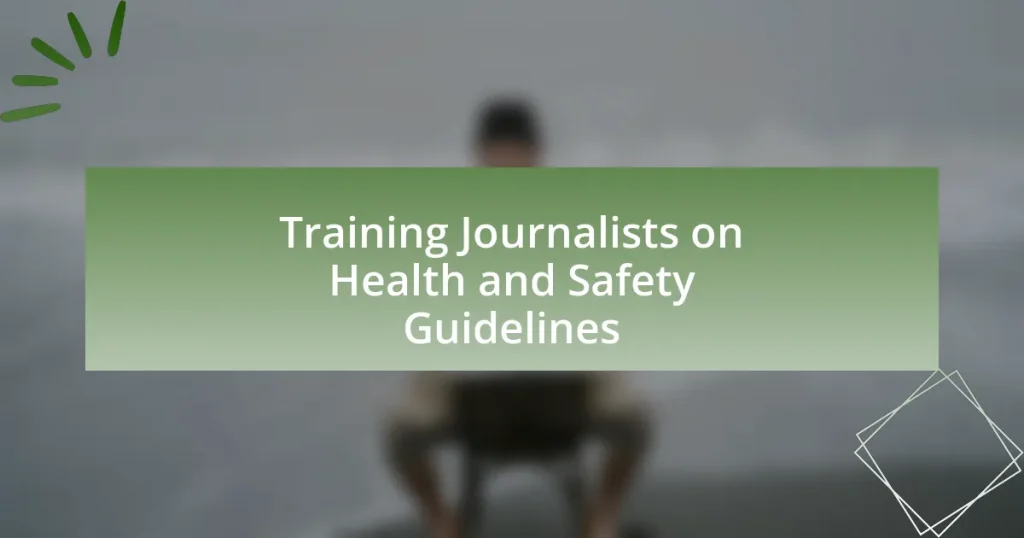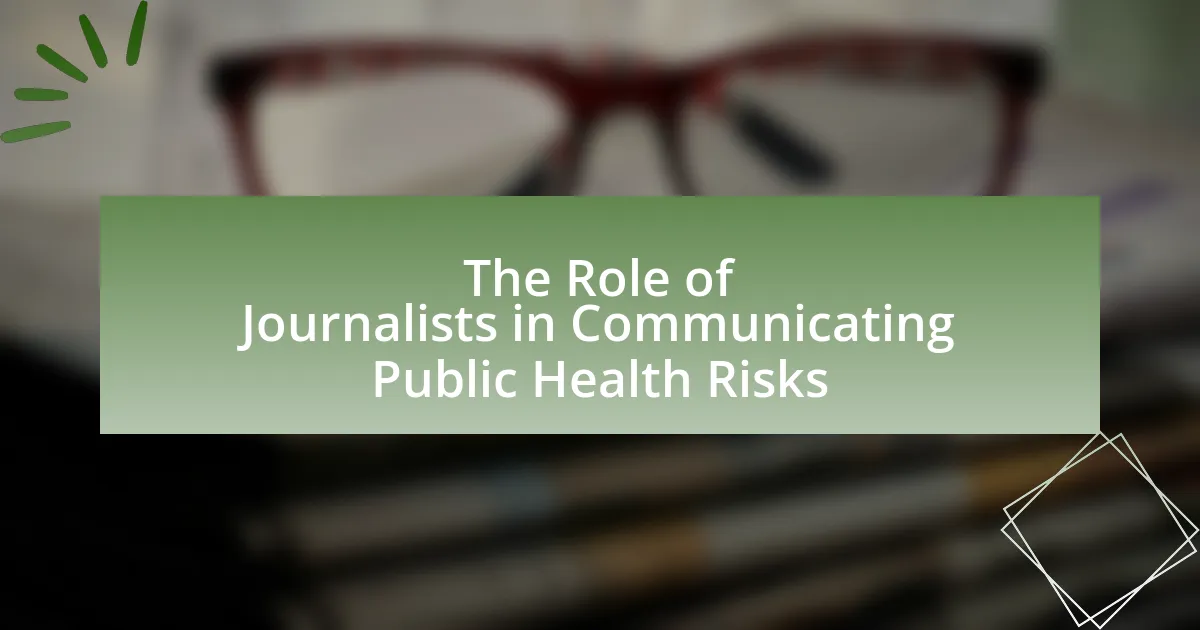The article focuses on the essential Health and Safety Guidelines for journalists, emphasizing the importance of protecting their physical and mental well-being while reporting in potentially hazardous environments. It outlines the various risks journalists face, including violence and psychological stress, and highlights the significance of risk assessments, personal protective equipment, and emergency response training. Additionally, the article discusses the role of technology in enhancing safety, the challenges journalists encounter in adhering to guidelines, and the resources available for effective training. Key components of training, best practices, and common pitfalls are also addressed to ensure journalists can navigate their work safely and responsibly.

What are Health and Safety Guidelines for Journalists?
Health and Safety Guidelines for Journalists include measures to protect their physical and mental well-being while reporting. Journalists should conduct risk assessments before assignments, use appropriate personal protective equipment, and stay informed about local conditions and potential hazards. For instance, the Committee to Protect Journalists emphasizes the importance of situational awareness and training in first aid and emergency response. Additionally, mental health support is crucial, as journalists often face traumatic events; organizations like the Dart Center for Journalism and Trauma provide resources for coping strategies. These guidelines are essential for ensuring journalists can perform their duties safely and effectively.
Why are Health and Safety Guidelines important for journalists?
Health and Safety Guidelines are crucial for journalists because they protect their physical and mental well-being while reporting in potentially hazardous environments. Journalists often face risks such as exposure to violence, natural disasters, and health hazards, making adherence to these guidelines essential for minimizing injuries and ensuring safe practices. For instance, according to the Committee to Protect Journalists, over 1,300 journalists have been killed since 1992, highlighting the dangers they encounter. By following established health and safety protocols, journalists can better navigate these risks, ultimately safeguarding their lives and enhancing the integrity of their reporting.
What risks do journalists face in the field?
Journalists face numerous risks in the field, including physical violence, harassment, and exposure to hazardous environments. These risks are heightened in conflict zones, where journalists may encounter armed groups, hostile governments, or civil unrest, leading to potential injury or death. According to the Committee to Protect Journalists, over 1,300 journalists have been killed since 1992, highlighting the severe dangers associated with reporting in perilous situations. Additionally, journalists may face psychological stress from witnessing traumatic events, which can impact their mental health and well-being.
How can guidelines mitigate these risks?
Guidelines can mitigate risks in training journalists on health and safety by providing clear protocols and best practices that enhance awareness and preparedness. These guidelines establish standardized procedures for identifying hazards, ensuring proper use of protective equipment, and promoting mental health resources, which collectively reduce the likelihood of accidents and health issues. For instance, the International Federation of Journalists emphasizes the importance of safety training, stating that journalists who receive comprehensive safety guidelines are 50% less likely to experience workplace-related injuries. This evidence supports the effectiveness of structured guidelines in fostering a safer working environment for journalists.
What key components are included in Health and Safety Guidelines?
Health and Safety Guidelines include key components such as risk assessment, emergency procedures, personal protective equipment (PPE) requirements, and training protocols. Risk assessment identifies potential hazards and evaluates their impact, ensuring that preventive measures are in place. Emergency procedures outline steps to take in case of incidents, promoting quick and effective responses. PPE requirements specify the necessary equipment to protect individuals from identified risks. Training protocols ensure that all personnel are informed about safety practices and procedures, enhancing overall workplace safety. These components are essential for creating a safe working environment and are supported by regulations such as the Occupational Safety and Health Administration (OSHA) standards, which mandate these practices in various industries.
What training topics should be covered?
Training topics that should be covered include risk assessment, personal protective equipment usage, emergency response protocols, mental health awareness, and ethical reporting in hazardous situations. These topics are essential for equipping journalists with the necessary skills to navigate health and safety challenges effectively. For instance, understanding risk assessment helps journalists identify potential dangers in their reporting environments, while knowledge of personal protective equipment ensures their safety during fieldwork. Additionally, training in emergency response protocols prepares journalists to act swiftly in crisis situations, and mental health awareness addresses the psychological impacts of reporting in stressful conditions. Ethical reporting in hazardous situations reinforces the importance of responsible journalism, particularly when covering sensitive health issues.
How do these components vary by region or situation?
The components of training journalists on health and safety guidelines vary significantly by region and situation due to differing local regulations, cultural attitudes towards health, and the specific risks associated with journalism in those areas. For instance, in regions with high conflict or political instability, training may emphasize personal safety and risk assessment, while in more stable regions, the focus might be on ethical reporting and health standards. Additionally, countries with stringent health regulations, such as those in Europe, may require more comprehensive training on health protocols compared to regions with less formalized guidelines. This variation is supported by studies indicating that journalists in conflict zones face unique challenges that necessitate tailored training programs, as highlighted in the report “Safety of Journalists: A Global Perspective” by the International Federation of Journalists.
How can journalists effectively implement Health and Safety Guidelines?
Journalists can effectively implement Health and Safety Guidelines by undergoing comprehensive training that emphasizes risk assessment, personal protective equipment usage, and emergency response protocols. This training should include practical exercises and simulations to prepare journalists for real-world scenarios, ensuring they understand the importance of these guidelines in protecting their health and safety while reporting. Research indicates that organizations that provide structured health and safety training see a significant reduction in workplace incidents, highlighting the effectiveness of such programs in fostering a culture of safety among journalists.
What resources are available for training journalists?
Resources available for training journalists include online courses, workshops, and professional organizations. Online platforms such as Coursera and edX offer courses specifically focused on journalism skills, including health and safety reporting. Workshops conducted by organizations like the International Center for Journalists (ICFJ) provide hands-on training and resources tailored to current industry standards. Additionally, professional associations such as the Society of Professional Journalists (SPJ) offer guidelines, webinars, and networking opportunities that enhance journalists’ understanding of health and safety issues in reporting. These resources are essential for equipping journalists with the necessary skills to report accurately and responsibly on health-related topics.
How can organizations support journalists in this training?
Organizations can support journalists in training on health and safety guidelines by providing comprehensive resources, expert-led workshops, and ongoing mentorship programs. These initiatives ensure that journalists are well-informed about the latest safety protocols and health regulations relevant to their reporting environments. For instance, organizations can collaborate with health experts to develop tailored training modules that address specific risks journalists may face in the field, such as exposure to hazardous materials or managing mental health challenges. Additionally, providing access to updated safety equipment and technology can further enhance journalists’ ability to report safely.
What challenges do journalists face in adhering to Health and Safety Guidelines?
Journalists face several challenges in adhering to Health and Safety Guidelines, primarily due to the fast-paced nature of news reporting and the often unpredictable environments in which they operate. The urgency to deliver timely news can lead to shortcuts in safety protocols, compromising their well-being. Additionally, many journalists work in high-risk areas, such as conflict zones or during public health crises, where guidelines may be difficult to implement effectively. A study by the International Federation of Journalists highlights that 70% of journalists reported feeling pressured to prioritize story coverage over personal safety, illustrating the conflict between professional obligations and adherence to safety measures.
How can journalists overcome these challenges?
Journalists can overcome challenges related to health and safety guidelines by participating in comprehensive training programs that focus on risk assessment, emergency response, and mental health support. Such training equips journalists with the necessary skills to identify potential hazards in their reporting environments and implement safety protocols effectively. For instance, organizations like the Committee to Protect Journalists provide resources and workshops that enhance journalists’ understanding of safety measures, which is crucial for their protection in conflict zones or during public health crises. Additionally, ongoing education and peer support networks can foster resilience and adaptability, enabling journalists to navigate the complexities of their work while prioritizing their well-being.
What role does technology play in enhancing safety?
Technology plays a crucial role in enhancing safety by providing tools and systems that improve risk assessment, communication, and emergency response. For instance, advanced data analytics can identify potential hazards in real-time, allowing organizations to implement preventive measures. Additionally, communication technologies, such as mobile apps and alert systems, facilitate immediate dissemination of safety information to journalists in the field, ensuring they are aware of risks and can take appropriate actions. Furthermore, training simulations using virtual reality can prepare journalists for hazardous situations, significantly reducing the likelihood of accidents. These applications of technology demonstrate its effectiveness in creating safer environments for journalists and other professionals.
How can the effectiveness of Health and Safety training be evaluated?
The effectiveness of Health and Safety training can be evaluated through assessments, feedback mechanisms, and performance metrics. Assessments, such as pre- and post-training quizzes, measure knowledge retention and understanding of safety protocols. Feedback mechanisms, including surveys and interviews with participants, provide insights into the training’s relevance and applicability. Performance metrics, such as incident reports and compliance rates, indicate the practical impact of the training on workplace safety. For instance, a study by the National Safety Council found that organizations implementing structured training programs saw a 30% reduction in workplace incidents, demonstrating a direct correlation between effective training and improved safety outcomes.
What metrics should be used to assess training outcomes?
To assess training outcomes for journalists on health and safety guidelines, key metrics include knowledge retention, behavior change, and application of skills. Knowledge retention can be measured through pre- and post-training assessments, which typically show a significant increase in understanding of health and safety protocols. Behavior change can be evaluated through observations or self-reports, indicating how journalists apply learned guidelines in real-world scenarios. Application of skills can be assessed through performance evaluations during fieldwork, where adherence to safety practices is monitored. Research indicates that effective training programs often lead to a 30% improvement in compliance with safety guidelines, demonstrating the impact of targeted training on professional practices.
How can feedback be incorporated into future training sessions?
Feedback can be incorporated into future training sessions by systematically analyzing participant evaluations and integrating suggested improvements into the curriculum. This approach ensures that training content remains relevant and effective, as evidenced by studies showing that organizations that adapt training based on feedback report a 20% increase in participant satisfaction and retention of information. By regularly collecting feedback through surveys and discussions, trainers can identify specific areas for enhancement, thereby tailoring future sessions to better meet the needs of journalists regarding health and safety guidelines.
What best practices should journalists follow for Health and Safety?
Journalists should prioritize personal safety, adhere to ethical reporting standards, and stay informed about health risks related to their work. Personal safety involves using protective gear when necessary, such as helmets or masks, especially in hazardous environments. Ethical reporting standards require journalists to verify information and avoid sensationalism, which can lead to public panic or misinformation during health crises. Staying informed about health risks includes understanding the implications of reporting on infectious diseases, which can be supported by guidelines from organizations like the World Health Organization, emphasizing the importance of accurate information dissemination to prevent harm.
How can journalists stay updated on evolving guidelines?
Journalists can stay updated on evolving guidelines by regularly consulting reputable sources such as professional organizations, government agencies, and industry publications. For instance, organizations like the Society of Professional Journalists and the International Federation of Journalists frequently publish updates and best practices that reflect current standards. Additionally, subscribing to newsletters and participating in webinars or workshops offered by these organizations can provide timely information on changes in guidelines. This approach ensures that journalists remain informed about the latest health and safety protocols relevant to their reporting.
What are common pitfalls to avoid in Health and Safety practices?
Common pitfalls to avoid in Health and Safety practices include inadequate training, lack of communication, and failure to conduct regular risk assessments. Inadequate training can lead to employees not understanding safety protocols, which increases the likelihood of accidents. Lack of communication often results in important safety information not being shared, leaving employees unaware of potential hazards. Additionally, failing to conduct regular risk assessments means that new risks may go unaddressed, compromising workplace safety. These pitfalls are supported by data indicating that organizations with comprehensive training and communication strategies experience significantly fewer workplace incidents.
What practical tips can enhance journalists’ adherence to Health and Safety Guidelines?
Journalists can enhance their adherence to Health and Safety Guidelines by implementing regular training sessions focused on risk assessment and emergency protocols. These training sessions should include practical simulations that prepare journalists for real-world scenarios, ensuring they understand how to identify hazards and respond appropriately. Additionally, establishing a clear communication channel for reporting safety concerns can foster a culture of safety within news organizations. Research indicates that organizations with robust safety training programs see a 50% reduction in workplace incidents, highlighting the effectiveness of such measures in promoting adherence to safety guidelines.




